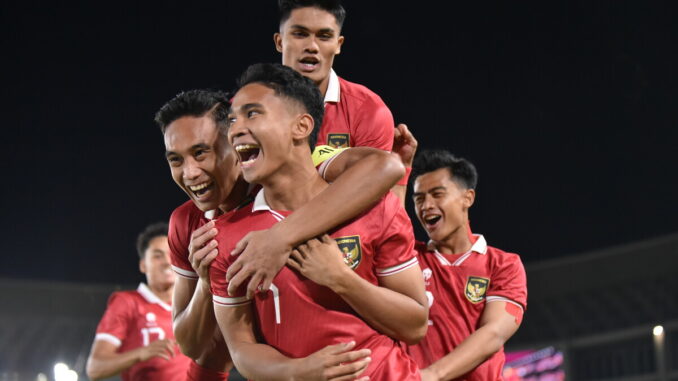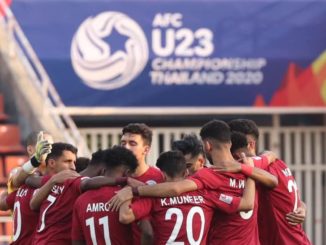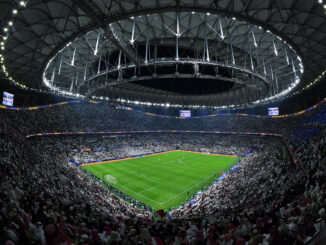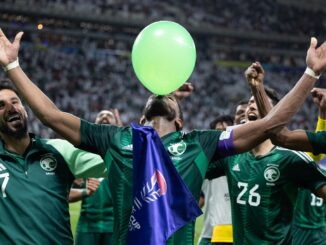
The race to Paris is on! The biennial U23 AFC Asian Cup kicks off in Qatar this coming week, with Olympic qualification the ultimate prize for the victorious few.
Two months on from Qatar’s home success at the senior Asian Cup, continental football quickly returns to the Emir state. A sense of déjà vu? Definitely. A sense of weariness? Perhaps.
While the tournament will have a feeling of familiarity about it – we all know the quality in infrastructure, stadiums and organisational ability demonstrated over the last few years, from everything from the AFC Champions League to the FIFA World Cup – the same questions lay at Qatar’s door, that of supporter appetite and playing conditions.
While attendance concerns were sufficiently quelled following a broadly successful Asian Cup, Qatar will be lucky to surpass an upward trend in numbers seen over the last few U23 tournaments.
2022’s U23 Asian Cup, used as an opportunity for Uzbekistan to demonstrate their capability of hosting more illustrious tournaments in the future, was a resounding success. The tournament brought with it increased engagement, the highest average attendance we’ve seen at this level to date, and crucially limelight, for a region regularly out of reach of even continental consideration.
Qatar can’t claim to be making any further strides in either of these regards, having sufficiently saturated the landscape over the last couple of years.
Another difficulty is in its timing. Having stepped into the breach as replacement hosts of the Asian Cup earlier this year, Qatar pushed back the staging of the U23s until mid-April. While we’re not talking about football being played out in the blistering Gulf summer; the humid evening air of Doha or out in Al-Rayyan in Spring is hardly ideal for organisers and players alike.
The move also prevents a full contingent of under-23 talent on display. Two years ago, the competition benefitted from being scheduled at the beginning of the European off-season, which overlapped with a FIFA international window, releasing the continent’s best talent to play in the competition.
This time, with no such requirement for clubs to release their players, compounded in being situated at such a pivotal time most teams’ domestic calendars – the tournament is already diminished of a few key stars.
Mitigations aside, the U23 Asian Cup has often delivered since its inception a decade ago. While some have been played out in broad preparatory mode, outside of the Olympic schedule, the direct Olympic qualification editions have always promoted a competitive environment.
This year, Asia competes for an extra opportunity to travel to Paris come the summer. Alongside the top three finishers (two finalists and the third-place victors), fourth place will face their African comparison, Guinea, for a further spot at the Olympic games.
After years of broadly the same names acquiring these slots though, can 2024 represent a step change in expectation at this level?
A changing tide?
It could be argued that Asia is currently experiencing a disruption of power. January’s Asian Cup was a disaster for the continental elite, with developing nations rising to the fore and competing strongly in the latter stages. Those improvements were borne out of the growth within younger age groups, which are promised to continue moving forward, as the breadth and depth of quality across the continent continues to swell.
This is best illustrated in the rising standards of football in Saudi Arabia. Clinching their first U23 Asian Cup title in Tashkent, in what was their second final appearance in succession, a previous dearth in impact at this stage has quickly turned around to some sustained momentum at all levels of the international game.
With their natural development from U20s through to U23 and senior level culminating in back-to-back World Cup appearances, their return to the elite in Asia has been comprehensively swift and built on an improving player base and investment in the game.
On the back of their first qualification for the Olympics in 25 years, back in Tokyo 2020, a repeat achievement is a clear goal in solidifying their status within the upper echelon of world football over the coming years.
The difficulties, however, may come as they transition between generations.
Pre-Saudi Pro League boom, young players were afforded opportunities to thrive at the top of the domestic game. With fewer openings available since the big-name influx, and the promising generation from 2022 having broadly departed, the next cohort may have less capability to meet such high expectations.
The retention of Saad Al-Shehri in the dugout is crucial; he’s brought tactical consistency to the youth pipeline that has seamlessly fed the national team picture. Utilising the likes of 2022 player of the tournament, Ayman Yahya, and final goalscorer, Ahmed Al-Ghamdi, may be crucial to their hopes of progression this time around, especially if the promising, but all too often frustrating figure of Abdullah Radif, struggles to replicate his undoubted ability in front of goal.
In warm up, their performances at March’s WAFF U23 Championship raised more questions than it did hope of replicating their title winning form, but experience in key areas should be enough to keep them in contention of featuring in the latter stages.
Their opponents in that final back in 2022, Uzbekistan, are conversely hitting an upward trajectory – growing from strength-to-strength over the last two years at every level of the game.
Having made the last four in the last three tournaments, the Olympic hoodoo still lingers over the White Wolves. Yet, recent success, at U20 level and at the Asian Games suggests this is the most likely generation to break the hold of such a heavy curse.
Building off their hosting, success on and off the pitch has permeated throughout Uzbek football. Heading into Qatar, the Uzbek Super League, which features a purposely injected U23 side, aptly named Olympic FC, continues as one of the youngest domestic leagues in Asia, and has been forced to close for the duration of the tournament. Demonstration, if any is needed, that this has been a collective endeavour to spur on the national team.
The team itself will be anchored by the familiar faces of Jasurbek Jaloliddinov, Khusyain Norchaev and Diyor Kholmatov, who have already impressed at various national team levels over the last few years. But it may be in the form of Alisher Odilov and Abdurauf Buriev, two of eight Olympic FC players under the tutelage of joint-club and national coach Timur Kapadze, who may make the biggest impression over the coming month.
The difference between being nearly men and overnight successes, however, may come down to the power (or lack) of persuasion.
As accepted in their pre-tournament press conference, Uzbekistan has arguably progressed their players “too well” in the last year or two; with five of their primed Olympic group now plying their trade abroad and thus out of reach for the tournament call up. While Rubin Kazan have been persuaded to part with Umarali Rakhmonaliev this month, the absence of Abbosbek Fayzullaev, Abdukhodir Khusanov and Khojimot Erkinov, three pivotal senior players two months ago in Qatar, will be hard to replace in their pursuit of Olympic qualification.
The indomitable duo reign supreme
While variety is hoped for, predictability is a safer bet. Since the Atlanta games in 1996, both South Korea and Japan have featured in all seven Olympic tournaments; not bad in a continent that only commands three qualification spots.
While they have experienced frustrating U23 Asian Cup campaigns in isolation – with only one final appearance between them over the last three tournaments – when Olympic qualification rolls around, the two jewels in Asian football’s crown regularly rise to the occasion.
The difference here comes in the immediate drawing of one another in the group stage. While both sides will be keen on having secured their places in the knockout stages by the time they meet on the final day of the group stage; the prospect of raking over their old rivalry early in the tournament raises an early tantalising assessment of their capabilities.
In the box seat, Korea have edged their neighbours out most recently at youth level, while the opposite can be felt at senior level. Champions in 2020, enroute to reach Tokyo, Korea’s resultant slump in 2022 has been reacted to positively, making it to the last four of the U20 World Cup last year, taking gold in October’s Asian Games, with victory over Japan in the final, and with triumph in March’s WAFF U23 invitational.
Hwang Sun-hong, the man currently caretaking the senior role following Jurgen Klinsmann’s spectacular exit, may start to see this tournament as an opportunity to put his name in the frame for the job full time.
The squad he has at his disposal could help him in doing just that. While the availability of Brentford’s Kim Ji-soo remains a question mark on the eve of the tournament, the supply of European-based Kim Min-woo, and Bae Jun-ho, alongside Kang Seong-jin and Eom Ji-sung who will offer a threat from out wide boasts a strong team on paper.
Depth is a strength for the Koreans once again, but individual effectiveness in central attacking positions may be their undoing.
For Japan, Go Oiwa’s rocky road as head coach hits its defining point. Having meandered their way through to the semis back in 2022, with over half of the same squad that is heading to Qatar, the team lacked flexibility and togetherness to contest for the title.
Their key strength is in midfield, anchored by Sint-Truiden-based duo Rihito Yamamoto and Joel Fujita, and supplemented by the mercurial 20-year-old Kuryu Matsuki, playing at his second, of a possible three, U23 championships for him personally.
The options in attack also look interesting. Mao Hosoya has featured for the seniors of late, but is out of goalscoring form this season, while the man in form Kotaro Uchino, who sparkled in the Asian Games, has no professional experience to point to.
With no great holes, and sizeable pedigree to point to in the run up, it may feel a little too obvious to point out – but if anyone can beat Korea or Japan, they’ll likely to be booking their flights to Paris shortly after.
The contenders and dark horses
Semi-finalists in the last two editions, Australia, remain strong contenders for another Olympic qualification, having edged out Uzbekistan on the Road to Tokyo in 2020.
The Olyroos continue to demonstrate impressive form under Tony Vidmar, making it to the semi-finals at Toulon last year, and the final of WAFF U23 tournament last month.
The depth in options, particularly in attack, where they’ve often come unstuck in previous youth competitions, allows them to call on the in-form Alou Kuol, brother Garang, and the once prodigious Mohamed Toure. Despite some heated questioning on the absence of Nestory Irankunda, Australia will once again be a tough team to stop.
They’ll initially face hosts Qatar, in the first round, a less daunting prospect than a decade ago perhaps when the Maroon dominated the youth field in the build up to their hosting of the World Cup in 2022. In recent years, magnified by their 9-1 reverse in the same matchup at U20 level, and back-to-back group stage exits at the U23s, the whisper of a crisis in Qatari football was looming large.
Their surprise Asian Cup victory offers Al-Annabi acspring to their step that they can turn a corner out of a few forgetful years. Their home support, that clearly had a contributing impact in their senior success, may well prove to their advantage once again, albeit in the more cosier confines of the Jassim bin Hamad.
Player wise, Portuguese coach Ilidio Vale is able to call on senior continental champion experience in the form of the compossed Jassem Gaber, and the ever-energetic Mostafa Meshaal.
The goalscoring threat looks towards the anticipated heir to Hassan Al-Haydos. Ahmed Al-Rawi, brother of two-time Asian champion Bassam, has already taken on such expectation of succeeding the Qatari great, having scored his first for his country in his second cap against Kuwait in the March window.
His often frustrated and isolated appearances in youth football, could well need some support, but if provided opportunities he offers a devastating impact on the break and a glimpse into the future of hope for the home nation’s football.
Iraq complete the set of usual challengers, yet restricted player availability dampens initial expectations. A broadly inexperienced squad at this level, but a developing one that featured at the U20 World Cup last year, the advantage of having arguably the most eye-catching talent on display in Ali Jassim will help their attacking merits, while the ever versatile Muntadher Mohammed offers them suitable depth in expertise in defensive areas.
From the outside, interest will be paid to debutants Indonesia who can commit a raft of senior national team players to the cause, including Marselino Ferdinan and Witan Sulaeman; to Tajikistan, looking to make it back-to-back surprises on the continental stage, calling up a broad selection of the same squad that made their name in Qatar two months back; and to the expectation surrounding Kuwait, once a credible threat at youth level. Could 2024 be the year where they start to regain that ground, under a stabilised Portuguese coaching team, and a growingly promising squad of players?
The prospect of an entertaining competition and shocks aside, the tournament also offers a glimpse at the future generation of Asian football, set to graduate to the senior stage over the coming decade. In humid conditions out in the mid-April Doha evening air, Asia’s generation next come under the microscope once again.
Photo: AFC
Listen to Episode 219 of The Asian Game Podcast as we discuss the AFC U23 Asian Cup and AFC Champions League semi-finals




